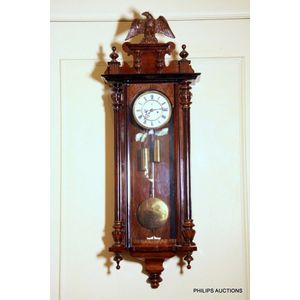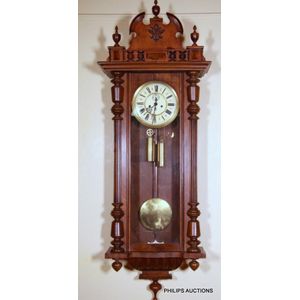Late 19th Century Gustav Becker Wall Regulator Clock
You must be a subscriber, and be logged in to view price and dealer details.
Subscribe Now to view actual auction price for this item
When you subscribe, you have the option of setting the currency in which to display prices to $Au, $US, $NZ or Stg.
- Finial - An architectural decoration, found on the upper parts of of an object. On furniture they are usually found on pediments, canopies and shelf supports. On smaller ceramic or silver items, such as spoons, they may decorate the top of the item itself, or the lid or cover where they provide a useful handle for removal.
Finials have a variety of shapes and forms. They may be urn-shaped, baluster shaped round or spiral, but usually taper into an upper point. Many real life shapes may also be used as finials, such as pineapples, berries, pinecones, buds, lotus and acorns. Sometimes animals such as a lion are depicted, or fish and dolphins. - Mahogany - Mahogany is a dense, close grained red-coloured timber from the West Indies and Central America. It was first imported into Europe in the the early 18th century and its use continued through the 19th century. It was popular for furniture making because of its strength, the wide boards available, the distinctive grain on some boards, termed flame mahogany and the rich warm colour of the timber when it was polished.. The "flame" was produced where a limb grew out from the trunk of the tree, and this timber was usually sliced into veneers for feature panels on doors, backs and cornices.
Some terms used to describe mahogany relate to the country from which it originally came, such as "Cuban" mahogany, "Honduras" mahogany etc. However unless the wood has been tested the names assigned are more a selling feature, rather than a true indication of the timber's origin. - Pendulum - The pendulum was discovered around 1602 by Galileo Galilei, and was adopted for time keeping by the Dutch mathematician and natural philosopher, Christiaan Huygens, who excelled in astronomy, physics, and horology.
The pendulum comprises a metal rod usually of brass or steel with a metal disk, known as a bob, at the end. The movement of the pendulum is driven by weights or a spring, and as a pendulum swings in a regular arc, it was found accuracy could be controlled to within a few seconds a week.
Timekeeping can be adjusted by changing the height of the bob on the rod, making the pendulum either swing slower or faster.
The disadvantage of the pendulum was that changes in temperature also changed the length of the pendulum, interfering with the accuracy of the clock, and so in the 18th century two types of mercurial pendulums were invented which countered the movement in the steel rod.
The pendulum was the world's most accurate timekeeping technology until the invention of the quartz clock, regulated by a quartz crystal, in 1927. - Broken Arch - An arch at the top of the clock, usually of half circle shape where the diameter is less than that of the frame from which it rises. The area in the broken arch may contain one or more subsidiary dials, the makers name, strike / silent mechanism, automata, phases of the moon or a painted scene. This design feature is found mainly on bracket clocks and longcase clocks.
This item has been included into following indexes:
-
clocks, type
- dial 274
- regulator, wall mounted 87
- wall 828
- Gustav Becker Clock Company (Germany) - clocks, makers or retailers 47
Visually similar items

A Vienna regulator clock, Last quarter, 19th century, the 'Alt Deutsch' style regulator with a finely shaped pediment with eagle crest and finials, the case with turned and fluted half pillars to a pagoda drop, having a Roman numeral chapter ring, minute m

Wall clock: antique walnut case with enamel dial. 92 cm

American wall clock, no key, has pendulum, approx 60 cm high, 32 cm wide

Vienna regulator wall clock with enamel dial
